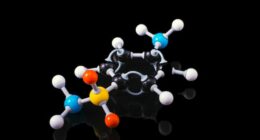Nickel and chrome are both metallic elements with different physical and chemical properties. Nickel is a silvery-white metal that is ductile and resistant to corrosion, while chrome is a hard, lustrous metal that is highly resistant to tarnishing and oxidation.
What is nickel?
(Image by WikiImages from Pixabay )

Nickel is a chemical element with the symbol Ni and atomic number 28. It is a silvery-white lustrous metal with a slight golden tinge. Nickel belongs to the transition metals and is hard and ductile. Pure nickel, while difficult to extrude, can be drawn easily, making it ideal for drawing wire. The metal is found in the Earth’s crust only in chemically combined form, save for small deposits found in alluvial deposits.
The important ore minerals of nickel are pentlandite and pyrrhoite (both iron-nickel sulfides), garnierite (a hydrous nickel silicate), millerite (a sulfide), and nickeline or schalenstein (a simple sulfide). Major producers of nickel ore include Australia, Russia, Canada, Brazil, Cuba, Indonesia, Philippines, and New Caledonia.
What is chrome?
(Photo by Ian Taylor on Unsplash )

Chrome is a chemical element with the symbol Cr and atomic number 24. It is the first element in group 6. It is a steely-grey, lustrous, hard and brittle transition metal. Chrome is used in metallurgy as an alloying agent for steel, in order to impart anti-corrosive properties. When chromium is used as an Alloying Agent for steels, it has the effect of scavenging oxygen and nitrogen from the melt, thus reducing oxidation and decarburization at high temperatures.
Nickel Vs. Chrome – Key differences
There are several key differences between nickel and chrome. Perhaps the most obvious is that nickel is a metal, while chrome is a coating. This means that nickel will never chip or peel, while chrome can.
Another difference is that nickel has a softer, warmer look, while chrome has a cooler, more modern look. This means that nickel is often used in traditional settings, while chrome is more common in contemporary designs.
Finally, nickel is more expensive than chrome. This is because it is a rarer metal and requires more work to apply as a finish.
Which is better: Nickel or Chrome?
The answer depends on the specific application and intended use. Nickel is often preferred for its ductility and resistance to corrosion, while chrome is valued for its hardness and resistance to tarnishing and oxidation. Ultimately, the better choice will depend on the specific properties required for the intended use.
What are the disadvantages of nickel plating?
Some disadvantages of nickel plating include:
- Porosity: Nickel plating can be porous, which can allow corrosive substances to penetrate and damage the underlying metal.
- Brittle: When nickel is deposited in thicker layers, it can become brittle and prone to cracking.
- Discoloration: Nickel plating can discolor over time, especially in humid environments or when exposed to acidic substances.
- Allergies: Some people can develop an allergic reaction to nickel, which can cause skin irritation and rashes.
- Environmental concerns: Nickel plating involves the use of toxic chemicals and can create hazardous waste, which can be harmful to the environment if not properly disposed of.
What are the disadvantages of Chrome plating?
- High Cost: Chrome plating can be expensive due to the high cost of the raw materials and the specialized equipment required.
- Brittle: Thick chrome plating can become brittle and prone to cracking, especially if the underlying metal is not properly prepared or if the plating is subjected to high stress.
- Environmental concerns: Chrome plating involves the use of toxic chemicals and can create hazardous waste, which can be harmful to the environment if not properly disposed of.
- Health Risks: Exposure to hexavalent chromium, a toxic chemical used in the chrome plating process, can cause respiratory problems, skin irritation, and even cancer.
- Thickness limitations: Chrome plating is typically applied in thin layers, which may not provide enough protection for some applications.
Is stainless steel chrome or nickel?
Stainless steel contains both chrome and nickel. Chrome is added to stainless steel to provide corrosion resistance, while nickel is added to improve the overall strength and ductility of the material. The amount of chrome and nickel added can vary depending on the specific grade of stainless steel and the intended application.
Can you mix nickel and chrome?
It is possible to mix nickel and chrome plating, but it can be challenging to achieve a uniform finish and ensure proper adhesion between the two layers.
If the nickel and chrome plating are applied sequentially, it is important to ensure that the nickel layer is properly prepared and plated to provide a suitable surface for the chrome plating to adhere to.
Alternatively, some plating processes involve depositing a layer of nickel-chrome alloy, which can provide a uniform and consistent finish with the desired properties of both metals.
In general, it is important to consult with a qualified plating expert to determine the best approach for achieving the desired finish and properties when mixing nickel and chrome plating.
How long does chrome and nickel plating last?
The lifespan of chrome and nickel plating can vary depending on several factors, including the thickness of the plating, the quality of the underlying metal, and the conditions under which the plated part is used.
In general, both nickel and chrome plating can provide durable and long-lasting protection against corrosion and wear. Thin layers of chrome or nickel plating may last for several years, while thicker layers can last for decades or even longer.
The lifespan of the plating can also be affected by exposure to harsh environmental conditions, chemicals, and mechanical stress. Proper maintenance and care can help to extend the lifespan of chrome and nickel plating.
The uses of nickel
Nickel is a versatile metal that is used in a wide range of applications, including:
- Manufacturing: Nickel is used in the production of stainless steel, which is widely used in the manufacture of industrial equipment, machinery, and consumer products.
- Batteries: Nickel is a key component of rechargeable batteries, including nickel-cadmium (NiCad) and nickel-metal hydride (NiMH) batteries.
- Electronics: Nickel is used in electronic components, such as connectors, switches, and capacitors.
- Aerospace: Nickel is used in the manufacture of aircraft parts, such as turbine blades, exhaust systems, and landing gear.
- Chemical processing: Nickel is used as a catalyst in various chemical processes, such as the production of fertilizers and petrochemicals.
- Coinage: Nickel is used to produce coins in many countries around the world.
- Jewelry: Nickel is used in the production of jewelry, especially in combination with other metals, such as silver and gold.
Nickel is a valuable and versatile metal that plays a crucial role in many industries and applications.
The uses of chrome
Chrome is a versatile metal that is used in a variety of applications, including:
- Automotive: Chrome is widely used in the automotive industry to provide a decorative and protective finish on various parts, such as wheels, grilles, and bumpers.
- Construction: Chrome is used in the construction industry to provide a durable and corrosion-resistant finish on various metal parts, such as door handles, hinges, and fittings.
- Aerospace: Chrome is used in the aerospace industry to provide a protective coating on various parts, such as engine components and landing gear.
- Household appliances: Chrome is used in the production of household appliances, such as refrigerators, ovens, and washing machines, to provide a decorative and corrosion-resistant finish.
- Medical equipment: Chrome is used in the production of medical equipment, such as surgical instruments and implants, due to its biocompatibility and resistance to corrosion.
- Plumbing: Chrome is used in the plumbing industry to provide a decorative and corrosion-resistant finish on various parts, such as faucets, showerheads, and pipes.
Chrome is a valuable metal that provides a durable and attractive finish in many different industries and applications.
Featured Image By – Renè Müller on Unsplash








